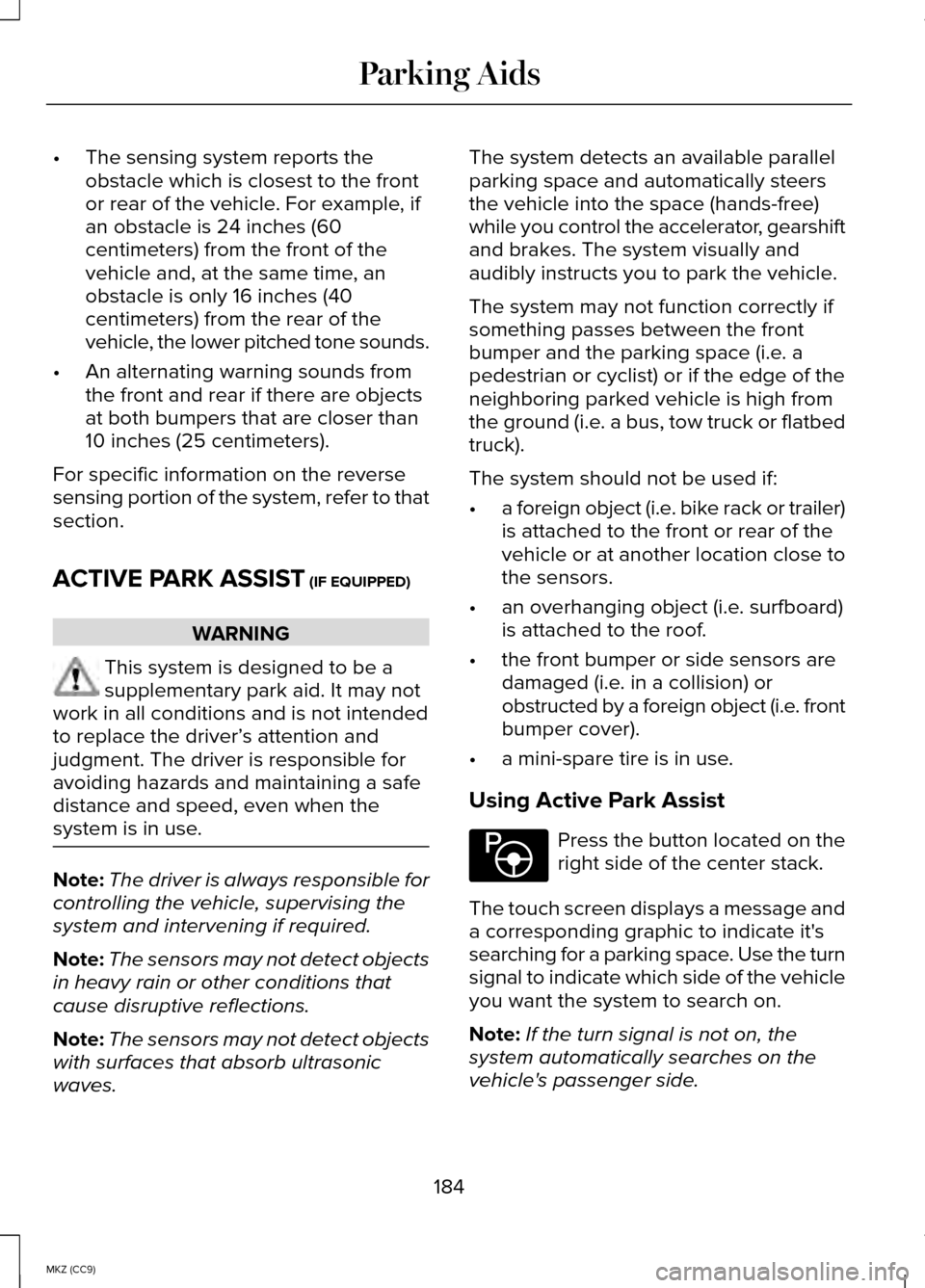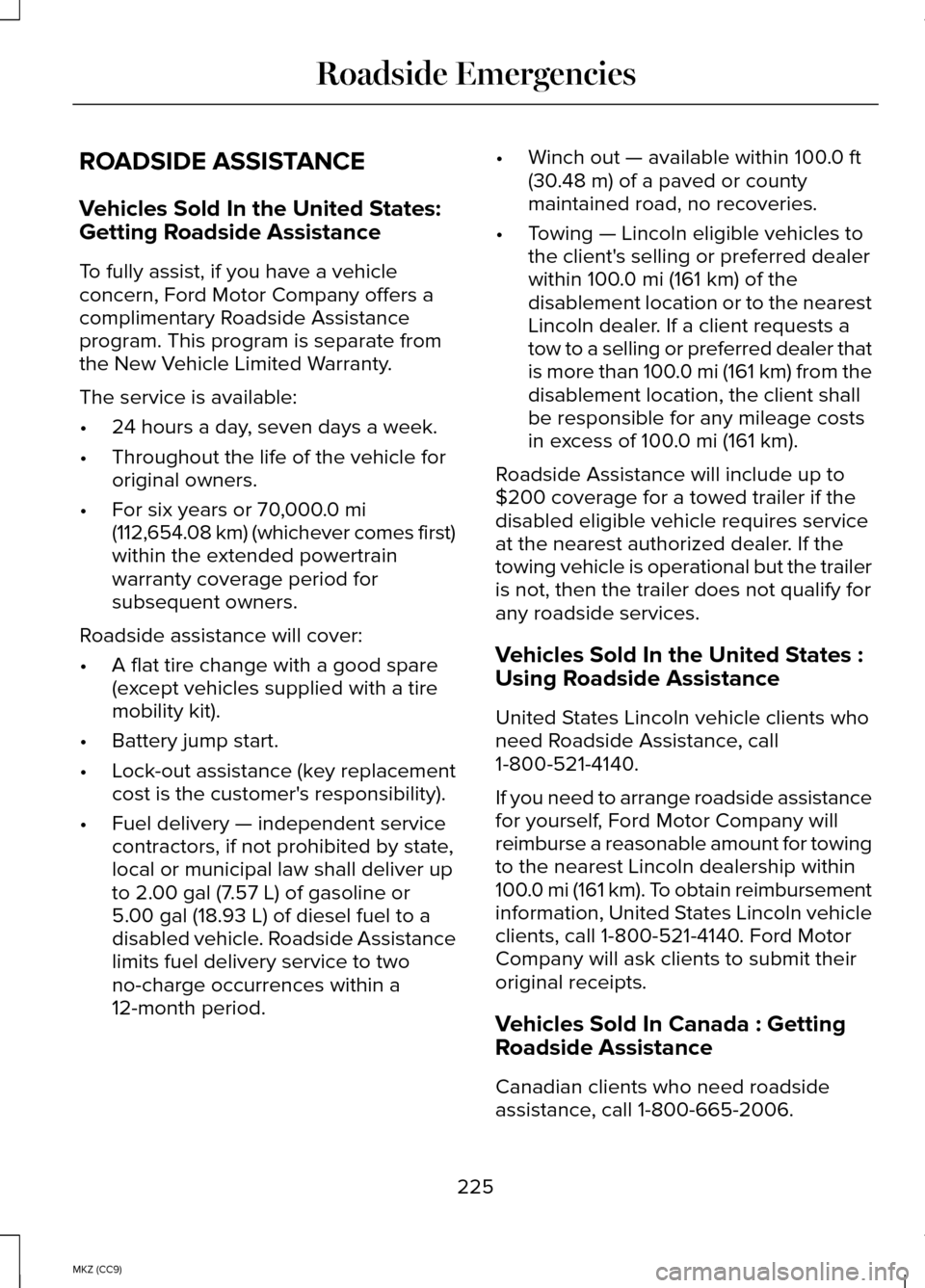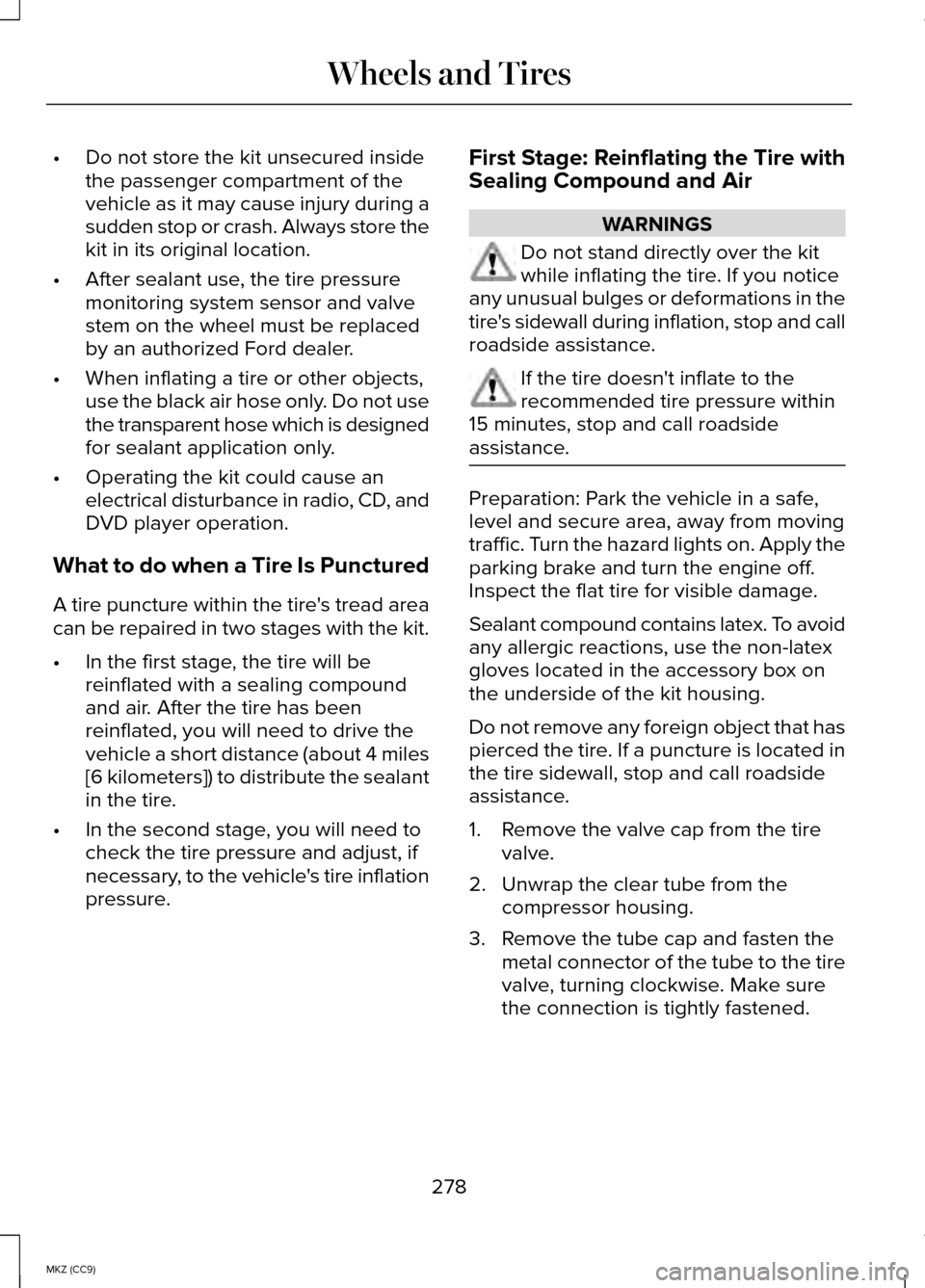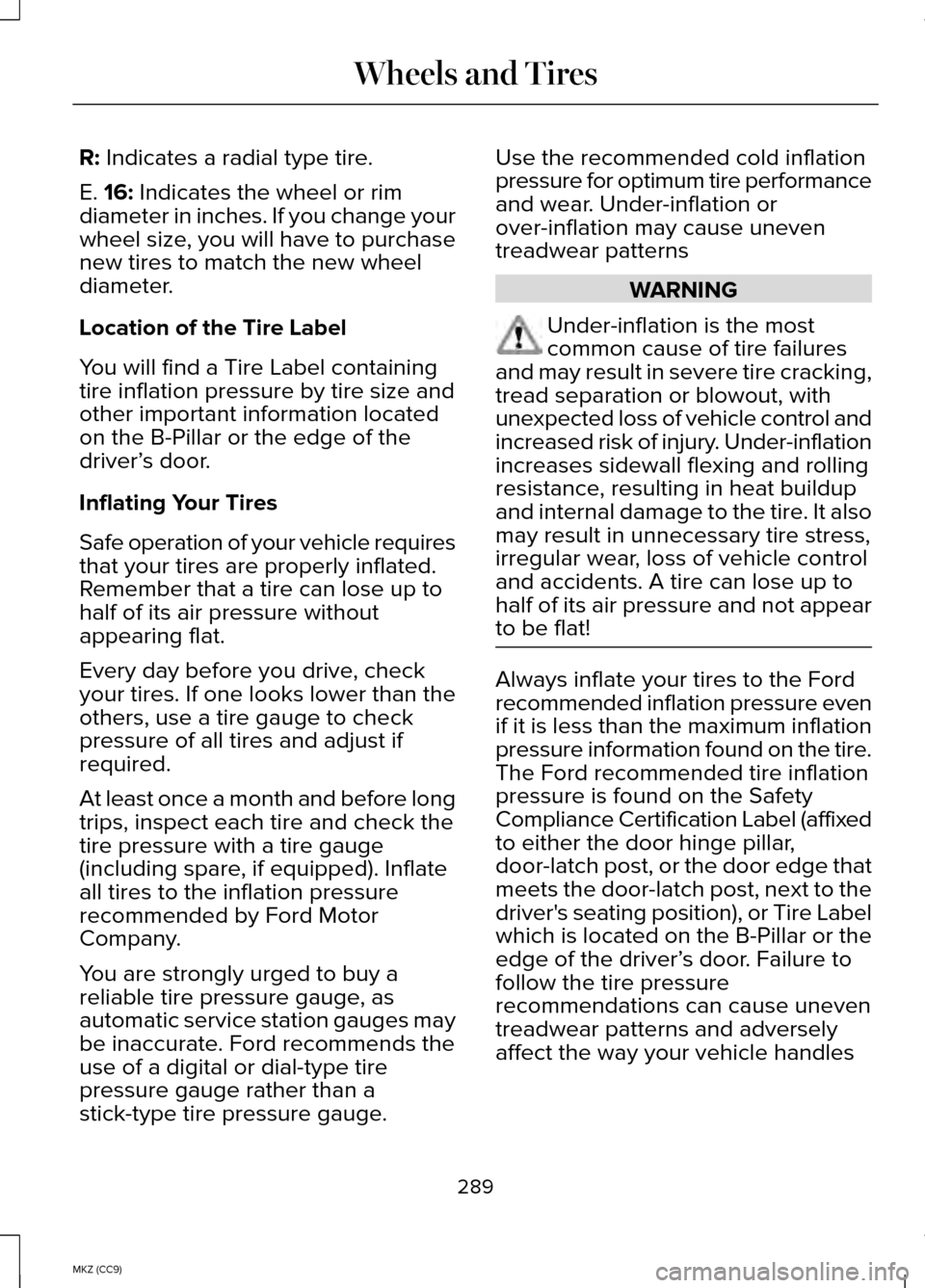spare tire location LINCOLN MKZ HYBRID 2014 Owners Manual
[x] Cancel search | Manufacturer: LINCOLN, Model Year: 2014, Model line: MKZ HYBRID, Model: LINCOLN MKZ HYBRID 2014Pages: 445, PDF Size: 3.8 MB
Page 186 of 445

•
The sensing system reports the
obstacle which is closest to the front
or rear of the vehicle. For example, if
an obstacle is 24 inches (60
centimeters) from the front of the
vehicle and, at the same time, an
obstacle is only 16 inches (40
centimeters) from the rear of the
vehicle, the lower pitched tone sounds.
• An alternating warning sounds from
the front and rear if there are objects
at both bumpers that are closer than
10 inches (25 centimeters).
For specific information on the reverse
sensing portion of the system, refer to that
section.
ACTIVE PARK ASSIST (IF EQUIPPED) WARNING
This system is designed to be a
supplementary park aid. It may not
work in all conditions and is not intended
to replace the driver’ s attention and
judgment. The driver is responsible for
avoiding hazards and maintaining a safe
distance and speed, even when the
system is in use. Note:
The driver is always responsible for
controlling the vehicle, supervising the
system and intervening if required.
Note: The sensors may not detect objects
in heavy rain or other conditions that
cause disruptive reflections.
Note: The sensors may not detect objects
with surfaces that absorb ultrasonic
waves. The system detects an available parallel
parking space and automatically steers
the vehicle into the space (hands-free)
while you control the accelerator, gearshift
and brakes. The system visually and
audibly instructs you to park the vehicle.
The system may not function correctly if
something passes between the front
bumper and the parking space (i.e. a
pedestrian or cyclist) or if the edge of the
neighboring parked vehicle is high from
the ground (i.e. a bus, tow truck or flatbed
truck).
The system should not be used if:
•
a foreign object (i.e. bike rack or trailer)
is attached to the front or rear of the
vehicle or at another location close to
the sensors.
• an overhanging object (i.e. surfboard)
is attached to the roof.
• the front bumper or side sensors are
damaged (i.e. in a collision) or
obstructed by a foreign object (i.e. front
bumper cover).
• a mini-spare tire is in use.
Using Active Park Assist Press the button located on the
right side of the center stack.
The touch screen displays a message and
a corresponding graphic to indicate it's
searching for a parking space. Use the turn
signal to indicate which side of the vehicle
you want the system to search on.
Note: If the turn signal is not on, the
system automatically searches on the
vehicle's passenger side.
184
MKZ (CC9) Parking AidsE146186
Page 227 of 445

ROADSIDE ASSISTANCE
Vehicles Sold In the United States:
Getting Roadside Assistance
To fully assist, if you have a vehicle
concern, Ford Motor Company offers a
complimentary Roadside Assistance
program. This program is separate from
the New Vehicle Limited Warranty.
The service is available:
•
24 hours a day, seven days a week.
• Throughout the life of the vehicle for
original owners.
• For six years or 70,000.0 mi
(112,654.08 km) (whichever comes first)
within the extended powertrain
warranty coverage period for
subsequent owners.
Roadside assistance will cover:
• A flat tire change with a good spare
(except vehicles supplied with a tire
mobility kit).
• Battery jump start.
• Lock-out assistance (key replacement
cost is the customer's responsibility).
• Fuel delivery — independent service
contractors, if not prohibited by state,
local or municipal law shall deliver up
to
2.00 gal (7.57 L) of gasoline or
5.00 gal (18.93 L) of diesel fuel to a
disabled vehicle. Roadside Assistance
limits fuel delivery service to two
no-charge occurrences within a
12-month period. •
Winch out — available within
100.0 ft
(30.48 m) of a paved or county
maintained road, no recoveries.
• Towing — Lincoln eligible vehicles to
the client's selling or preferred dealer
within
100.0 mi (161 km) of the
disablement location or to the nearest
Lincoln dealer. If a client requests a
tow to a selling or preferred dealer that
is more than 100.0 mi (161 km) from the
disablement location, the client shall
be responsible for any mileage costs
in excess of
100.0 mi (161 km).
Roadside Assistance will include up to
$200 coverage for a towed trailer if the
disabled eligible vehicle requires service
at the nearest authorized dealer. If the
towing vehicle is operational but the trailer
is not, then the trailer does not qualify for
any roadside services.
Vehicles Sold In the United States :
Using Roadside Assistance
United States Lincoln vehicle clients who
need Roadside Assistance, call
1-800-521-4140.
If you need to arrange roadside assistance
for yourself, Ford Motor Company will
reimburse a reasonable amount for towing
to the nearest Lincoln dealership within
100.0 mi (161 km). To obtain reimbursement
information, United States Lincoln vehicle
clients, call 1-800-521-4140. Ford Motor
Company will ask clients to submit their
original receipts.
Vehicles Sold In Canada : Getting
Roadside Assistance
Canadian clients who need roadside
assistance, call 1-800-665-2006.
225
MKZ (CC9) Roadside Emergencies
Page 280 of 445

•
Do not store the kit unsecured inside
the passenger compartment of the
vehicle as it may cause injury during a
sudden stop or crash. Always store the
kit in its original location.
• After sealant use, the tire pressure
monitoring system sensor and valve
stem on the wheel must be replaced
by an authorized Ford dealer.
• When inflating a tire or other objects,
use the black air hose only. Do not use
the transparent hose which is designed
for sealant application only.
• Operating the kit could cause an
electrical disturbance in radio, CD, and
DVD player operation.
What to do when a Tire Is Punctured
A tire puncture within the tire's tread area
can be repaired in two stages with the kit.
• In the first stage, the tire will be
reinflated with a sealing compound
and air. After the tire has been
reinflated, you will need to drive the
vehicle a short distance (about 4 miles
[6 kilometers]) to distribute the sealant
in the tire.
• In the second stage, you will need to
check the tire pressure and adjust, if
necessary, to the vehicle's tire inflation
pressure. First Stage: Reinflating the Tire with
Sealing Compound and Air WARNINGS
Do not stand directly over the kit
while inflating the tire. If you notice
any unusual bulges or deformations in the
tire's sidewall during inflation, stop and call
roadside assistance. If the tire doesn't inflate to the
recommended tire pressure within
15 minutes, stop and call roadside
assistance. Preparation: Park the vehicle in a safe,
level and secure area, away from moving
traffic. Turn the hazard lights on. Apply the
parking brake and turn the engine off.
Inspect the flat tire for visible damage.
Sealant compound contains latex. To avoid
any allergic reactions, use the non-latex
gloves located in the accessory box on
the underside of the kit housing.
Do not remove any foreign object that has
pierced the tire. If a puncture is located in
the tire sidewall, stop and call roadside
assistance.
1. Remove the valve cap from the tire
valve.
2. Unwrap the clear tube from the compressor housing.
3. Remove the tube cap and fasten the metal connector of the tube to the tire
valve, turning clockwise. Make sure
the connection is tightly fastened.
278
MKZ (CC9) Wheels and Tires
Page 291 of 445

R: Indicates a radial type tire.
E.
16: Indicates the wheel or rim
diameter in inches. If you change your
wheel size, you will have to purchase
new tires to match the new wheel
diameter.
Location of the Tire Label
You will find a Tire Label containing
tire inflation pressure by tire size and
other important information located
on the B-Pillar or the edge of the
driver’ s door.
Inflating Your Tires
Safe operation of your vehicle requires
that your tires are properly inflated.
Remember that a tire can lose up to
half of its air pressure without
appearing flat.
Every day before you drive, check
your tires. If one looks lower than the
others, use a tire gauge to check
pressure of all tires and adjust if
required.
At least once a month and before long
trips, inspect each tire and check the
tire pressure with a tire gauge
(including spare, if equipped). Inflate
all tires to the inflation pressure
recommended by Ford Motor
Company.
You are strongly urged to buy a
reliable tire pressure gauge, as
automatic service station gauges may
be inaccurate. Ford recommends the
use of a digital or dial-type tire
pressure gauge rather than a
stick-type tire pressure gauge. Use the recommended cold inflation
pressure for optimum tire performance
and wear. Under-inflation or
over-inflation may cause uneven
treadwear patterns
WARNING
Under-inflation is the most
common cause of tire failures
and may result in severe tire cracking,
tread separation or blowout, with
unexpected loss of vehicle control and
increased risk of injury. Under-inflation
increases sidewall flexing and rolling
resistance, resulting in heat buildup
and internal damage to the tire. It also
may result in unnecessary tire stress,
irregular wear, loss of vehicle control
and accidents. A tire can lose up to
half of its air pressure and not appear
to be flat! Always inflate your tires to the Ford
recommended inflation pressure even
if it is less than the maximum inflation
pressure information found on the tire.
The Ford recommended tire inflation
pressure is found on the Safety
Compliance Certification Label (affixed
to either the door hinge pillar,
door-latch post, or the door edge that
meets the door-latch post, next to the
driver's seating position), or Tire Label
which is located on the B-Pillar or the
edge of the driver’
s door. Failure to
follow the tire pressure
recommendations can cause uneven
treadwear patterns and adversely
affect the way your vehicle handles
289
MKZ (CC9) Wheels and Tires